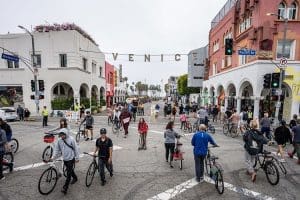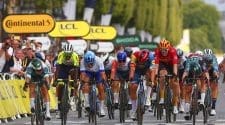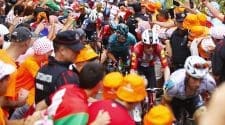At the 2024 Tour de France new milestones are set to be reached in many areas. For the first time, the event will start in Italy and, for the first time, the riders will go through the roads which made the names of Marco Pantani, Gino Bartali and Fausto Coppi legends. Another remarkable change that deviates from past records will be the venue for the last stage of the event since the Olympic Games are being prepared, and this will not occur in Paris. This year the final stage will feature a very fast time trial and the winner of the tour might be determined by the result of this time trial instead of the traditional celebratory final circuit.
It is characteristic of the Tour de France to display hardships: for example, plenty of well-known, tough ascents through the Alps and Pyrenees. This edition follows through with this legacy by having a succession of stages that challenge cyclists with humongous-sized mountains. Interestingly, the first stage is set to break a record and become the hardest stage to be launched in the Tour de France by the day with the most elevation gains. On the other hand, the fourth stage is predicted to reach another height of elevation and marks the start of the event in France.
Tour de France: Figures, Dates, and Venues
This year’s tour will boldly traverse a total length of 3,492 kilometers that takes off with a breathtaking journey through four nations: Italy, San Marino, Monaco, and France. Riders will tackle the diverse terrains of four major mountain ranges: the Apennines, the majestic Alps-Italy and France, the Corisa Central and the impressive Pyrenees. This tour will be made to demonstrate the limits of cycling competency, with four summit passing and another 8 sprint stages. Offering 27 different climbs the A listers’ ability will be evaluated under the utmost scrutiny. The race also uses two time trials, adding this extra layer of strategy and sport challenge. That means that the competitors will have to put all their efforts during the whole race in order to achieve a victory.
The Tour starts on Saturday June 29 th and finishes after three weeks on Sunday, July 21st.
For the first time, the map of the Tour de France has Italy listed as its country of origin where the event starts. The first three stages happen in Bel Paese before the race finally crosses over to France during Stage 4.
Route of the Tour de France
The 2024 edition of Tour de France will be staged in 21 challenging stages, as well as two recuperation days. The circuit includes various kinds of terrains such as the mountains, the asphalt and the green countryside covering the race over a course of three weeks.
The Florentine already sets out a tough start by covering 206 km of hill slopes where riders have to climb 3.8 km in total and finish the stage with the last 25 km climb to the finish line. This might be inconvenient for sprinter’s teams because it might hinder their planning.
The preceding hilly stage was followed by stage 2 spanning from Cesenatico to Bologna of 200 km with six climbs including the tough double climb of San Luca which precedes a fast descent into Bologna.
Stage 3 will be a little bit of rest with a 225 km flat course from Piacenza to Turin, which will be the first sprinters’ stage in this year’s tour.
The Stage 4 transitions into the Alps landscaping, and the cyclists enjoy the view along the 138 km course from Pinerolo to Valloire with a number of edgy climbs, such as Sestrières and Galibier, and then finishes with a descent.
The alpine challenge is followed by the easier Stages 5 and 6 which feature flat routes of St Vulbas and Dijon respectively, allowing successful sprint finishes.
Stage 7 will be an important one since both time trial and climbing phases are involved, a non-eliminatory 25 km long test in Nuits-Saint-Georges to Gevrey-Chambertin will kick off the most challenging part of the Tour for the contenders.
Stage 8, despite it being flat, has enough uphills to block the breakaway, and it could have an eventual impact on a sprinter breakaway Semur-en-Auxois to Colombey-Les-Deux-Eglises.
Stage 9 is the 199 km hilly route that starts in Troyes and connects it back to Troyes. The final networking phase poses the most exciting part of what climbs 14 gravel roads, which adds up to 32 km to the distance, a considerable part of which occurs in the last 35 km.
Wind can be a big factor for Stage 10 from Orléans to Saint-Amand-Montrond, as it is predominantly flat but it is necessary to take care as there are some portions where the peloton could split, so all the contenders should be on alert again.
It is at the beginning of 11th stage of Tour de France that the neutral start is held, followed by a remarkable 4,300m of ascent and later 60km to go to Evaux-les-Bains – Le Lioran, totaling 211km. On the other side those in the top tier might hold back although many will compete for the King of the Mountains title and stage wins. The race then goes downwards a bit when it reaches the top of the Category 3 climb of Col de Font de Cere, and ends up right at Le Lioran.
Stage 12 after the mountainous route will be a 204 km flat route from Aurillac to Villeneuve-sur-Lot and will likely see a sprinter’s battle towards the stage win, as the crowds will be anticipating the Pyrenees.
Stage 13, methodically spread over a distance of 171 km from Agen to Pau, is the first to acquaint the riders with the Pyrenees mountain range edge. Pau, the city very familiar with Tour, might have a difficult finish for the sprinters, proving the surprise nature of the 8th stage.
The legendary Tourmalet forms the core part of Stage 14, which is a 152 km mountain test to Pau – Saint-Lary-Soulan (Pla d’Adet) with an accumulated elevation gain of nearly 4,000m. Such changes to the route may put a jolt on how each rider places themselves throughout the race, especially in the runs towards the top of the Pla d’Adet.
Stage 15, which lasts for 198 kms from Loudenvielle to Plateau de Beille, poses the biggest challenge and more fun among all the stages of the Tour this year. The initial ascent of the race is unstoppable; with a fierce climb that will lead us to the summit of the 1780m peak to the Plateau de Beille.
In Stage 16, a 187 km flat route from Gruissan to Nîmes offers the last chance for sprinters before the road gets more elevated and wind offends the contestants’ strategies.
Stage 17 starts in Saint-Paul-Trois-Châteaux over 178 km with a very difficult conclusion at the steep Col du Noyer and the last climb to the Côte de Superdévoluy.
Stage 18 offers a short pause from the difficult mountains, but the hilly 179 km road to Gap-Barcelonnette has few stretches that could still allow breakaways or launch counter attacks in the final.
The peloton is going to fight with the Cime de la Bonette in Stage 19 during the race 145 km from Embrun to Isola 2000, thus returning to Europe’s highest road after 16 years and pushing the riders to their limits when they go up the three high-altitude climbs.
Stage 20, a grueling mountainous effort of 133 km from Nice to Col de la Couillole is where the aspirants for the podium complete the ultimate showdown and is one of the most challenging mountain stages on the tour, before the concluding time trial.
Ultimately, Stage 21 mixes up the typical grand finale in favor of a 35.2km individual time trial from Monaco to Nice, a more historical context of the race, which results in a brilliant and unexpected finish of the 2024 Tour de France.
Expectations leading to the race?
Vingegaard took command of the previous year’s competition, securing a victory over the two-time champion Pogačar with a margin of 7:29. This year, in addition to lacking support from Roglic, Vingegaard will find himself contending with the Slovenian powerhouse as well. After Roglic moved to Bora-Hansgrohe at the last season’s close, the dynamic between these two is set to add an exciting layer of intrigue for fans following the race.
And despite the formidable palmarès of his rivals and keeping in mind any unpredictable detours, Vingegaard will take his place on the start line in Florence as the clear favorite. The division of this role even being without Roglic, the team Jumbo-Visma as a whole remains the number one contender once again.
For the first time in his Tour de France career, Evanepoel will race this year. He has already been labeled as standing a chance on the podium. The 2022 Vuelta a España and 2023 world TT champion had a good run at the Giro d’Italia until a Covid test turned his race upside down. He ups his game to make a signature this year, and with a bit of luck, a yellow jersey isn’t hard to imagine during the race.
Richard will merge with his Alpecin-Deceuninck guys, who competed for the green jersey last year. We’ll see indeed whether Astana will be able to satisfy the hopes of Cavendish from the water of eternal youth.
How to watch the 2024 Tour de France
Perceiving the race of *Tour de France 2024* and its excitement and pure competitive spirit, which cannot be compared to anything as it can only be felt by my presence at the race. The globe’s fans can relish this legendary road cycling spectacular from the beginning, through the finish, and using various outlets to be broadcast. In the UK, ITV4 will be in charge of coverages while Eurosport will provide the European audience. In the United States, viewers have the alternative between USA Network/NBC Sports if they like cable, or they may watch it on Peacock. For those fans who will be in Australia, SBS is their station, but in New Zealand, the race will be aired on Sky Sports, thus, will not deprive the cycling enthusiasts worldwide the chance to cheer as they watch every minute of the race.
How To Bet On Tour De France In 2024
The Tour De France is unmatchable either in sports or in the sports betting world and gains huge audiences across the globe as it features stages that test breaking points of human endurance and cycling skill. At the same time, crowds are magnetized from all over the world, thus the show is interesting not only for the spectators but also for the betting society as the game is unique and with so many gambling opportunities. Along with many, sports betting and online casino platforms like DraftKings is a distinctive choice for those who are interested in betting on this race. Quality customer service, security of payment systems and number of betting markets that DraftKings has are known, we can say that is a comprehensive betting which caters both seasoned bettors and newbies. With a simplistic design that relegates placing bets on the Tour De France to a straightforward and pleasurable activity, tracking and keeping customers’ data safe form the highest priority.
The fans in search for alternatives who want to explore beyond DraftKings options can have a variety of suitable platforms among which are platforms such as FanDuel and BetMGM with compensatory odds on the Tour De France. To get the most out of betting, it is advisable for bettors to look up the latest information about the races, look into who has been performing better among competitors and teams and check if the performance of these teams or riders would be a good ground for betting. In fact, one can learn by posting in forums or even betting groups since some of those people can be really helpful. Firstly, strategic and fact-based betting decisions coupled with the high-end and customer-centric platforms of today’s betting companies could provide the spectators a dynamic and engaging betting experience amid the exciting and thrilling Tour De France spectacle.
Photo by Pixabay





















